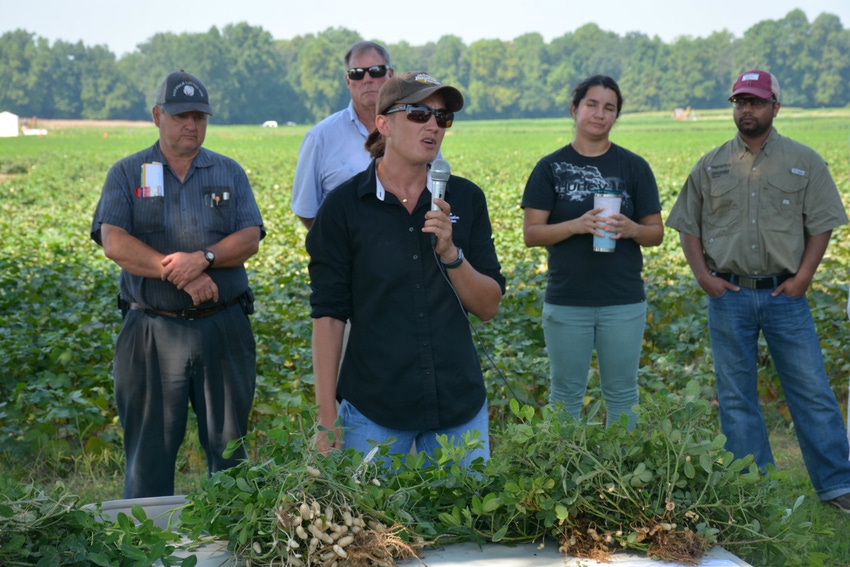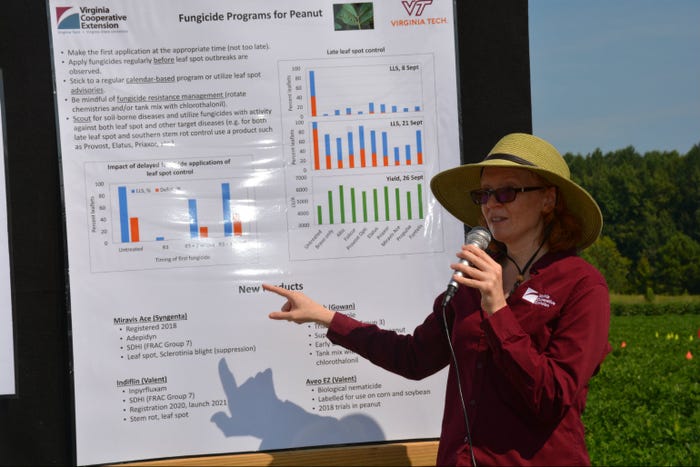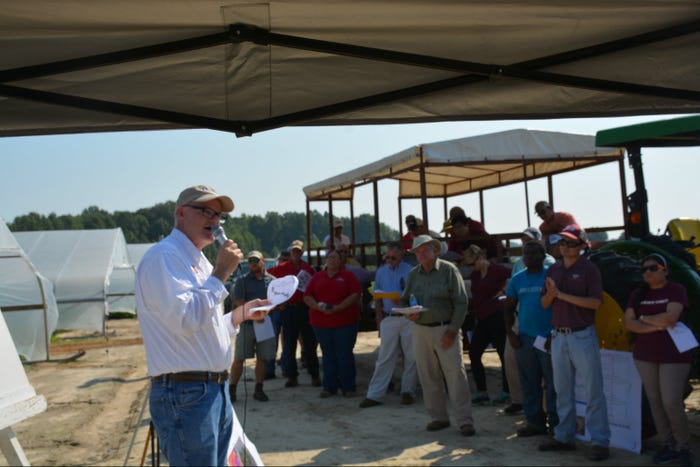
Diseases, thrips and weeds are a never-ending challenge for Virginia peanut farmers. At this year’s Virginia Peanut Tour pointers were offered to better manage these pests.
When it comes to managing peanut diseases, it’s important to make early fungicide applications before you see the disease, right around R3 or the beginning pod stage, advises Dr. Hillary Mehl, assistant professor of plant pathology at the Virginia Tech Tidewater Agricultural Research and Extension Center in Suffolk.
“It’s important to make your applications on time,” Mehl stressed at the tour held at the Tidewater Center on Aug. 15.
For leaf spot control, fungicide applications must be made well before you see symptoms in the field. Mehl said don’t delay fungicide applications, because once leaf spot inoculum begins building in the plant the disease becomes difficult to control. When you see lesions on the leaves there’s trouble.
“Also, be mindful of fungicide resistance management. Rotate chemistries. Tank-mix different modes of action. It’s also important to scout for soil borne diseases and utilize fungicides with activity against problems such as stem rot,” Mehl said, pointing out that there are a number of fungicide products which offer both leaf spot and stem rot control.
Meantime, Dr. Sally Taylor, assistant professor of entomology at Virginia Tech, says every year Virginia farmers must treat for thrips in peanuts. She pointed to Virginia Tech research conducted in 50 trials over the past five years that show it paid to treat for thrips about 75 to 80 percent of the time.
As for insecticides, Thimet proved to be the most consistent product, but Taylor said all the thrips control tools available today perform well, but efficacy can vary by location. She noted that Admire Pro works best for peanut thrips control in North Carolina, while Thimet works best in Virginia.
“All these products had a return between 7.5 and 16 percent yield increase over control and that is averaged over the past five years,” Taylor explained.
This year has been a very challenging one for thrips in the Commonwealth. Taylor said thrips injury is rated an eight this year on the thrips injury scale where a zero is no injury and a 10 is dead plants.
“Eight was the highest thrips injury index I’ve seen in Virginia,” Taylor said. “That means half the leaves had injury and 75 percent of the buds had injury. All the rain that kept us from planting kept their hosts lush and fresh. We had cooler weather, wetter weather. Our plants didn’t get off to a great start.”
Taylor noted that multiple acephate sprays were required at the research station to control thrips this year.
“Typically, in Virginia, our untreated thrips injury hovers around a six which is 50Virginia peanuts sustain heavy thrips damage, other challengespercent leaves damaged and less than 25 percent terminal bud injury,” she said.
Dr. Ames Herbert, Taylor’s predecessor in Suffolk, has said the economic breaking point for thrips in Virginia is six. Taylor said she agrees with that assessment.
“Do we know how the end of the season is going to shake out when we first start? No. That’s why having one of these good in-furrow products in the ground when you plant is so important,” Taylor said. “This year I’ve seen the least effect of acephate of any year working with it in either Virginia or North Carolina, in cotton or in peanuts, and that concerns me because this product is really our only opportunity for IPM (integrated pest management) with thrips.”
Taylor explains that other insecticide products are applied in the plant or in the ground ahead of the insect, before you have even seen a bug. Acephate is needed to clean things up.
“In the next few years we need to figure out why it’s not working for us and what rates can make it remain effective. Undoubtedly the weather this year played into that. Orthene is one of our least rain-fast products, so if you’re out spraying ahead of a storm and it’s a real frog strangler it’s probably going to wash off your plants,” Taylor said.
Turning to weed control, Dr. David Jordan, North Carolina State University Extension peanut specialist made the trip north to Suffolk from Raleigh to offer advice for Virginia peanut farmers. He emphasized the importance of early-season weed control to provide the best return for money invested.
“If I were to encourage you on weed control, and I know everybody has a budget, I would rather folks spend more money up front than spending it later on. You’ll get to the same place a lot less expensively,” Jordan said. “If you’re skimping on herbicides up front, you’re probably going to spend just as much cleaning up fields and you’re probably not going to quite have the yields you would otherwise.”
One key to effective weed control in peanuts is to establish an optimum plant population. Jordan advises five plants per foot of row. Good seedling vigor is important as is applying the correct herbicide at the correct rate.
He encourages a good intensive herbicide program up front, encourages farmers to overlap their residuals, and advises rotating herbicide modes of action to manage resistance.
Jordan also emphasizes the importance of hand-pulling escaped Palmer amaranth and common ragweed.
“Do the best you can to be on time with the right rate, and that will slow down the resistance development in those populations. Use the right adjuvant, making sure you get the optimum performance out of those herbicides,” Jordan said.

Dr. Hillary Mehl says for leaf spot control, fungicide applications must be made well before you see symptoms in the field.

Dr. David Jordan emphasizes the importance of early-season weed control to provide the best return for the investment.
About the Author(s)
You May Also Like






